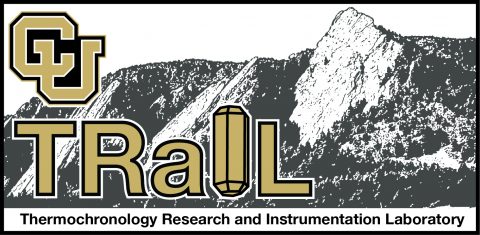PREPARING FOR A VISIT TO THE CU TRAIL FACILITY

When considering a visit to the CU TRaIL, please familiarize yourself with our lab’s statement on diversity, equity, and inclusion.
Preparing your samples for analysis is one of the most time consuming aspects of (U-Th)/He thermochronology. Experienced users can prepare 2-3 apatite samples or 3-4 zircon samples per day, while beginners will move much more slowly. There are a variety of things you can do to help expedite your sample preparation and most efficiently use your time and funding. Here are some suggestions for things you can do before arriving in Boulder to help things go smoothly and quickly:
1. Make sure your separates contain the mineral you are interested in.
Unfortunately there are some lithologies that just don’t have the minerals you want to date. We highly recommend screening your mineral separates prior to visiting the lab to make sure that you’ll have something to prepare. If you are unfamiliar with identifying the mineral you are interested in feel free to contact the lab. You can ship your samples ahead of time and have CU TRaIL lab personnel quickly screen them to make sure they contain what you want to analyze before booking travel!
2. Have pure mineral separates.
Hunting through large and impure mineral separates can make sample preparation overly time consuming. In addition, samples that contain dust sized material or magnetic grains can significantly decrease your ability to see, screen, and manipulate grains of interest. It is therefore important to try to remove as much of the non-target minerals as you can. At CU, our standard mineral separation procedure is designed to produce as pure of a mineral separate as possible. In short, your samples should have gone through both heavy liquid AND magnetic separation steps. Please contact CU staff for advice if you are unsure of your mineral separation procedures. CU’s general strategy is as follows:
- Crush the sample
- Pulverize the sample
- Use a Wilfley table to concentrate the heavy fraction, proceed with only the heaviest minerals from the Wilfley table.
- Use a hand magnet to remove very magnetic minerals
- Use a slope Frantz magnetic separator to progressively remove more and more magnetic fractions. If we are interested in monazite, titanite, or other phases that can be magnetic, they will come off in different steps. We typically use a minimum of 3 steps of Frantzing.
- Use LMT to sink zircon and apatite and float other minerals.
- Use MI to separate zircon from apatite.
- Have a prioritized list of samples.
Depending on how much time it takes you to prepare samples, you may not be able to complete all of the work you had intended to do. We find it helpful to focus first on the most critical samples. Any lower priority samples left unfinished can either be saved for another trip or prepared by CU staff.
3. Make sure you schedule enough time.
As mentioned above, beginning users may take a day or more per sample. Average preparation time is closer to 2-3 samples per day, but this depends greatly upon the mineral you are analyzing, the quality of the separate, and the quality of the target minerals themselves. If your planned stay is short (a few days), then the CU TRaIL lab can be reserved for both the day and evening. Longer stays may require CU students and staff to use the facilities in the evening, depending on schedules and availability.


